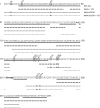Identification of phosphorylated residues on varicella-zoster virus immediate-early protein ORF63
- PMID: 20089801
- PMCID: PMC2888152
- DOI: 10.1099/vir.0.019067-0
Identification of phosphorylated residues on varicella-zoster virus immediate-early protein ORF63
Abstract
Efficient replication of varicella-zoster virus (VZV) in cell culture requires expression of protein encoded by VZV open reading frame 63 (ORF63p). Two-dimensional gel analysis demonstrates that ORF63p is extensively modified. Mass spectroscopy analysis of ORF63p isolated from transiently transfected HEK 293 and stably transfected MeWo cells identified 10 phosphorylated residues. In VZV-infected MeWo cells, only six phosphorylated residues were detected. This report identifies phosphorylation of two previously uncharacterized residues (Ser5 and Ser31) in ORF63p extracted from cells infected with VZV or transfected with an ORF63p expression plasmid. Computational analysis of ORF63p for known kinase substrates did not identify Ser5 or Ser31 as candidate phosphorylation sites, suggesting that either atypical recognition sequences or novel cellular kinases are involved in ORF63p post-translational modification.
Figures


Similar articles
-
Nuclear import of the varicella-zoster virus latency-associated protein ORF63 in primary neurons requires expression of the lytic protein ORF61 and occurs in a proteasome-dependent manner.J Virol. 2008 Sep;82(17):8673-86. doi: 10.1128/JVI.00685-08. Epub 2008 Jun 18. J Virol. 2008. PMID: 18562514 Free PMC article.
-
The varicella-zoster virus (VZV) open reading frame 47 (ORF47) protein kinase is dispensable for viral replication and is not required for phosphorylation of ORF63 protein, the VZV homolog of herpes simplex virus ICP22.J Virol. 1995 Nov;69(11):7367-70. doi: 10.1128/JVI.69.11.7367-7370.1995. J Virol. 1995. PMID: 7474171 Free PMC article.
-
Varicella-Zoster virus IE63, a major viral latency protein, is required to inhibit the alpha interferon-induced antiviral response.J Virol. 2007 Aug;81(15):7844-51. doi: 10.1128/JVI.00325-07. Epub 2007 May 16. J Virol. 2007. PMID: 17507475 Free PMC article.
-
VZV ORF47 serine protein kinase and its viral substrates.Curr Top Microbiol Immunol. 2010;342:99-111. doi: 10.1007/82_2009_5. Curr Top Microbiol Immunol. 2010. PMID: 20186612 Review.
-
Varicella-zoster virus open reading frame 66 protein kinase and its relationship to alphaherpesvirus US3 kinases.Curr Top Microbiol Immunol. 2010;342:79-98. doi: 10.1007/82_2009_7. Curr Top Microbiol Immunol. 2010. PMID: 20186610 Free PMC article. Review.
Cited by
-
ORF7 of Varicella-Zoster Virus Is Required for Viral Cytoplasmic Envelopment in Differentiated Neuronal Cells.J Virol. 2017 May 26;91(12):e00127-17. doi: 10.1128/JVI.00127-17. Print 2017 Jun 15. J Virol. 2017. PMID: 28356523 Free PMC article.
-
A comparison of herpes simplex virus type 1 and varicella-zoster virus latency and reactivation.J Gen Virol. 2015 Jul;96(Pt 7):1581-602. doi: 10.1099/vir.0.000128. Epub 2015 Mar 20. J Gen Virol. 2015. PMID: 25794504 Free PMC article. Review.
-
Rapid Detection of the Varicella-Zoster Virus Using a Recombinase-Aided Amplification-Lateral Flow System.Diagnostics (Basel). 2022 Nov 25;12(12):2957. doi: 10.3390/diagnostics12122957. Diagnostics (Basel). 2022. PMID: 36552964 Free PMC article.
-
Hands-on workshops as an effective means of learning advanced technologies including genomics, proteomics and bioinformatics.Genomics Proteomics Bioinformatics. 2013 Dec;11(6):368-77. doi: 10.1016/j.gpb.2013.10.002. Epub 2013 Dec 6. Genomics Proteomics Bioinformatics. 2013. PMID: 24316330 Free PMC article.
-
Varicella zoster virus infection of human fetal lung cells alters mitochondrial morphology.J Neurovirol. 2016 Oct;22(5):674-682. doi: 10.1007/s13365-016-0457-0. Epub 2016 May 31. J Neurovirol. 2016. PMID: 27245593 Free PMC article.
References
-
- Ambagala, A. P., Bosma, T., Ali, M. A., Poustovoitov, M., Chen, J. J., Gershon, M. D., Adams, P. D. & Cohen, J. I. (2009). Varicella-zoster virus immediate-early 63 protein interacts with human antisilencing function 1 protein and alters its ability to bind histones h3.1 and h3.3. J Virol 83, 200–209. - PMC - PubMed
-
- Baiker, A., Bagowski, C., Ito, H., Sommer, M., Zerboni, L., Fabel, K., Hay, J., Ruyechan, W. T. & Arvin, A. M. (2004). The immediate-early 63 protein of varicella-zoster virus: analysis of functional domains required for replication in vitro and for T-cell and skin tropism in the SCIDhu model in vivo. J Virol 78, 1181–1194. - PMC - PubMed
-
- Bontems, S., Di Valentin, E., Baudoux, L., Rentier, B., Sadzot-Delvaux, C. & Piette, J. (2002). Phosphorylation of varicella-zoster virus IE63 protein by casein kinases influences its cellular localization and gene regulation activity. J Biol Chem 277, 21050–21060. - PubMed
-
- Chen, J. J., Gershon, A. A., Li, Z. S., Lungu, O. & Gershon, M. D. (2003). Latent and lytic infection of isolated guinea pig enteric ganglia by varicella zoster virus. J Med Virol 70, S71–S78. - PubMed
Publication types
MeSH terms
Substances
Grants and funding
LinkOut - more resources
Full Text Sources
Miscellaneous

